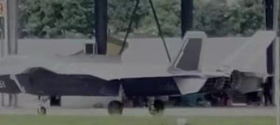so this is better than current EOTS equipped in J-20A .. ? means its newer generation EOTS
Doesn't EOTS on J-20A already provide air to surface capabilities? The paper is about an improvement to enable high resolution in wide area in the same way as "Advanced EOTS" for F-35 block 4. I believe this new EOTS is the equivalent to LM's "Advanced EOTS".
The paper quoted this link from LM where it shows two video clips of the their "Advanced EOTS".
View attachment 113856
Yes. The key objective is to enable high resolution in wide-area reconnaissance mode (as high as staring mode) by scanning and stiching in real time. The earlier generation only reaches high resolution in staring mode by telephoto lense. In wide area mode, wide angle lense is used on the same sensor leading to lower resolution (same pixel count on a large field of view). The new EOTS uses the telephoto lense for wide area by introducing a scanning mirror. Each frame covers the whole sensor and the frames are stiched in real time creating a larg image of high resolution.
View attachment 113857
I'll answer both together.
So, first of all I think the term "EOTS" is a very bad one to use generically.
EOTS is the name for the AAQ-40 which is on F-35's chin -- but people have been using it as a name for all types of electro optic sensors with low observable faceted housings on an aircraft's chin. Not ideal.
I have consistently used the term "EO IRST" for J-20's system on its chin, i.e." Electro Optic Infra Red Search and Track" as that is a more general and generic term as we don't know its actual name.
Technically speaking, the kind of system that EOTS/AAQ-40 is, means that it is a type of EO IRST.
To answer both of your questions -- in the case of J-20, its EO IRST has an opaque rear aspect, and the actual sensor itself likely isn't designed to be able to rotate to the rear or rear-ventral sector. This somewhat makes sense as it is primarily an air to air fighter meaning the frontal and frontal/ventral/side aspects are the most important.

OTOH, the AAQ-40 on F-35 has a full 360 degree sector transparent housing, which is important to enable the sensor to cover all aspects, and that is particularly important for surveilling and targeting ground targets as your aircraft needs to be able to fly circular orbits over a target including to do so during the egress as you leave the target.

That said, a 360 degree aspect housing is also useful for air to air roles because it still lets you keep a track on aerial targets in the rear/rear-ventral aspect if needed, so it isn't a surprise if J-20 gets a newer EO IRST in future with a transparent 360 degree housing. It doesn't necessarily mean it will have an air to ground targeting role.


